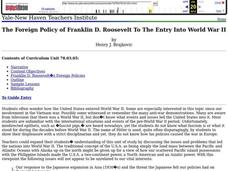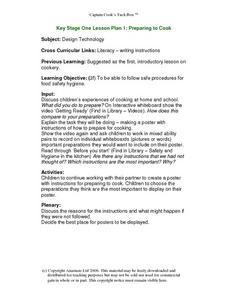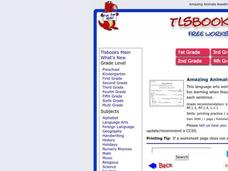Curated OER
Number Crunching
Students are shown 3-5 different types of crunches as well as the correct Fitnessgram curl-ups. They do sets of different types of crunches and count the total number by using multiplication skills. Studnets do multiple sets and count...
Curated OER
Why Oil and Water Don't Mix
Second graders explore why oil and water do not mix. They make and record their predictions and observe the experiment in which cooking oil is mixed with a glass of water. Students discuss why they think the oil and water did not mix and...
Curated OER
Counseling
Learners read a book as a group about bullies and being mean to one another. They answer questions as a class and discuss what to do instead if you are ever in this situation.
Curated OER
Humanitarian Issues in Afghanistan
Students examine the difficulties being faced by Afghan society, specifically by women and children. They discover what different aid agencies are doing to resolve these difficulties. They present to the class any initiatives they may...
Curated OER
The Foreign Policy of Franklin D. Roosevelt To The Entry Into World War Ii
Students examine the U.S.A.'s entry into World War II, and Franklin DO. Roosevelt's foreign policy. They analyze the life of I.E.., the election of 1932, and the New Deal.
Curated OER
Lab Report Template
Students write a paragraph (complete sentences) which explains what they did in the lab.
Curated OER
Exploring Tonal Memory in a One Computer Setting with Orff Instruments
Students listen to a made up melody sung by a classmate and sing it back. They discuss the outcomes as a class regarding what they did well when singing the short melody back. They then listen to a melody/pattern played on xylophone and...
Curated OER
Real Life Rights
Students consider modern applications to the Bill Of Rights (how does Ammendment 4 apply to locker searches?) students prepare and role play a mock trial to explore the finer points of the relevance ot the Bill of Rights in the 21st...
Curated OER
Lusitania: Murder on the Atlantic
Students explore the pride of the Cunard line and a jewel in the British crown; a floating four star hotel. But during World War I, the RMS Lusitania carried more than well-to-do travelers luxuriating in her sumptuous appointments.
Curated OER
Preparing to Cook
Students explore cooking. They follow safe procedures for food safety hygiene. Students discuss their experiences of cooking at home and school. They discuss what they did to prepare to cook. Students view a video. They create a poster...
Curated OER
The Great Big Especially Beautiful Easter Egg
Students make predictions about the book The Great Big Especially Beautiful Easter Egg by doing a picture walk. In this comprehension lesson plan, students read the book, see if their predictions were right, and draw pictures of their own.
Curated OER
Coins
Second graders observe and demonstrate how to count the value of assorted coins. They discuss a story from their Math Storybook, and as a class solve a variety of problems using activity sheets. Students then independently complete a...
Curated OER
Human Body
Fifth graders determine what muscles do and identify the different types. In this muscle lesson, 5th graders discuss what they know about muscles before looking at the book, The Human Body by Jonathan Miller. They take a teacher made...
Curated OER
The Structure And Functions of Proteins
Ninth graders investigate the structure of proteins and how it affects their function. They build a protein model with four helix units and describe how this structure aids the protein in doing its jobs.
Curated OER
The Truth And Owning Up
Young scholars investigate the moral obligation of telling the truth and what the implications are for not doing so. They define what a lie is and how it deviates from the truth. The skill of mending a mistake is taught to encourage...
Curated OER
Picture Perfect
Students work together in groups to research Afghanistan in the 1970s and today. After reading a story about a Peace Corps volunteer, they discuss things they must do in their community they believe are unneccessary. They end the lesson...
Curated OER
When, Why, What, How, Who?
In this matching answers with their questions worksheet, students read when, why, what, how, who, and do you questions and match their appropriate answers. Students match 8 answers and click the answer button to check.
Curated OER
Worksheet 8
In this math worksheet, students explore how the use of implicit differentiation does not give the solutions to the differential equation. Then they write the definitions to the vocabulary related to differential equations.
Curated OER
Viewing 'The Dinner Party' by Judy Chicago
Young scholars examine Judy Chicago's feminist art piece, The Dinner Party. Questions for viewing, activities, and student resources are provided. Students examine the composition of the piece and can be asked to do further...
Curated OER
Life of a Soldier after the Civil War Lesson Plan: What's in a Name
Students explore the concept of institutional bias. In this Civil War lesson plan, students read case studies on the treatment of Irish and African-American veterans who did not receive their pensions from the war. Students discuss their...
Curated OER
Downloading Music
Students study the effect that downloading has had on the music industry. As a class, students discuss what they know and do not know about the laws of music downloading. Small groups create a marketing plan to help reduce the amount...
Curated OER
Amazing Animals
What do the words dog, drink, play, and sitting have in common? They are the words that little ones will use as they read and complete four different sentences. They can use and color the helpful images related to each...
Local School Directory
Learning About Sentence Structure
What does a sentence need? A subject and a verb, and some adverbs and adjectives to make it more interesting! After examining sentence structure together, class members can practice adding adverbs and adjectives to short sentences...
Curated OER
Going to a Party: Say vs. Tell
In this say vs. tell activity, students fill in the blanks to sentences with forms of say and tell. Students do this for 8 sentences.

























